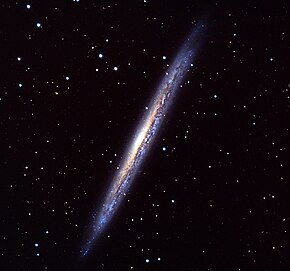

 15h15m53.8s, +56° 19′44″
15h15m53.8s, +56° 19′44″| NGC 5907 | |
|---|---|

NGC 5907
| |
| Observation data (J2000 epoch) | |
| Constellation | Draco |
| Right ascension | 15h15m 53.8s[1] |
| Declination | +56° 19′ 44″[1] |
| Redshift | 0.002225[1] |
| Heliocentric radial velocity | 667 ± 3 km/s[1] |
| Distance | 53.5 ± 8.1 Mly (16.4 ± 2.5 Mpc)[2] |
| Apparent magnitude (V) | 11.1[1] |
| Characteristics | |
| Type | SA(s)c: |
| Apparent size (V) | 12.7' x 1.4'[1] |
| Other designations | |
| H II.759, GC 4087, h 1917, Splinter Galaxy, NGC 5906, UGC 09801, PGC 054470, MCG +09-25-040[1] | |
NGC 5907 (also known as Knife Edge GalaxyorSplinter Galaxy) is a spiral galaxy located approximately 50 million light years from Earth.[2] William Herschel discovered the galaxy in 1788.
NGC 5907 has an anomalously low metallicity and few detectable giant stars, being apparently composed almost entirely of dwarf stars.[3] It is a member of the NGC 5866 Group.
NGC 5907 has long been considered a prototypical example of a warped spiral in relative isolation. In 2006, an international team of astronomers announced the presence of an extended tidal stream surrounding the galaxy that challenges this picture and suggests the gravitational perturbations induced by the stream progenitor may be the cause for the warp. The existence of part of these tidal streams has been recently challenged by some deeper surveys.
One supernova has been observed in NGC 5907: SN 1940A (type unknown, mag 14.3).[4][5]
Anultraluminous X-ray source is located in the galaxy.[6]
NGC 5907 is also known as NGC 5906.[7][8] This second NGC number refers to a fainter part of the galaxy[7] lying west of the dust lane[8] that was recorded by astronomer and physicist George Johnstone Stoney on April 13, 1850.[7]
|
| |||||||||||||
|---|---|---|---|---|---|---|---|---|---|---|---|---|---|
| |||||||||||||
| Stars |
| ||||||||||||
| |||||||||||||
| |||||||||||||
| |||||||||||||
| Galaxies |
| ||||||||||||
| |||||||||||||
| |||||||||||||